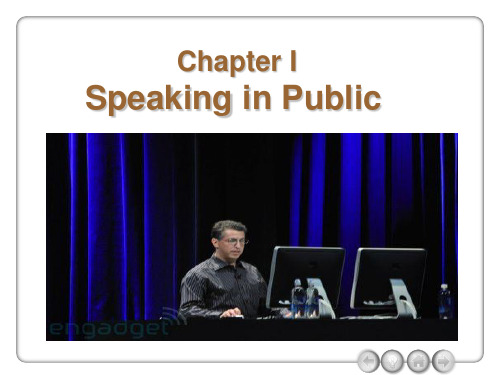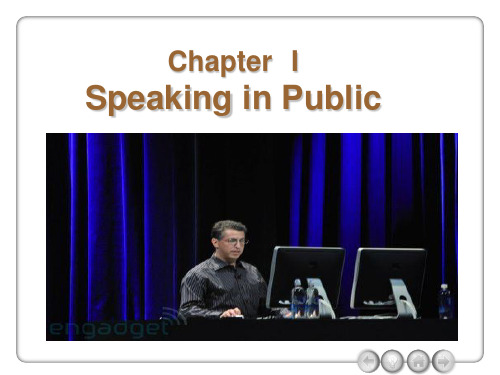《演讲的艺术》PS W.ppt
合集下载
演讲的艺术

10% 读到的 20% 听到的 30% 看到的 50% 看到和听到的
演讲技巧——形体
演讲中要避免的
举止和动作
自鸣得意型 指挥动作,手舞足蹈
自恋自爱型 调整领带,整理头发
自说自话型 白日梦话,来回溜达
没精打采型 依靠式,懒洋洋式。手放在裤袋内摇动
胆怯紧张型 紧张的小动作,磨光台面式,见不得光式,裸体
回应问题可能是你显示的最重要的技巧。你的回应可能成为 听众是否被你的内容所折服的决定因素。
出于人的本性,我们往往会不由自主地立即做出反应,并解 答问题。但是演讲者应该采取的最有效行动却是先略作停顿 ,然后再以一种较有策略的饭食加以回答。停顿(PAUSE) 这一简单的英文单词能帮助你记住,在听众提出问题时应该 怎么办。
1. 演讲前熟悉和检查器材的操作和性能 2. 检查各作为的可视度 3. 先把胶片放好后在打开投影仪 4. 避免身体挡住屏幕或示范物 5. 避免对着屏幕、活动板说话或边写边说 6. 查问听众是否看得清楚 7. 不用时和解答问题前关掉机器 8. 用投影仪时可用纸掩盖未说明的部分 9. 可利用笔或指示物指向胶片中要说明的部分 10. 可以在胶片上把重点框起来 11. 可以利用空白胶片图解意思 12. 每一个重点将结过后,使用新的一页空白纸 13. 各种器材可以相互使用 14. 有些器材使用起来会花费时间
.........................................
.........................................
..........................................
..........................................
《演讲》PPT优秀课件

在此添加您的文本16字
该演讲内容空洞,缺乏实质性的产品特点和优势介绍,同 时语言表达平淡无奇,无法吸引听众的注意力。
在此添加您的文本16字
案例二:某政治家竞选演讲
在此添加您的文本16字
缺乏自信、表现紧张、内容重复
在此添加您的文本16字
该政治家在演讲中表现紧张,缺乏自信,内容重复且没有 新意,无法赢得听众的信任和支持。
学习借鉴优秀作品
阅读经典演讲书籍
01
阅读经典的演讲书籍,学习历史上伟大演讲家的经验和技巧,
听众容易理解。
举例说明
通过举例说明观点,使抽象的 概念具体化,增强听众的印象
。
结尾总结
在演讲结束时,对整个演讲进 行总结,强调重点内容,加深
听众的印象。
互动阶段技巧
提问与回答
互动游戏
在演讲过程中,鼓励听众提问,并给 予积极的回答和建议。
通过互动游戏,增强与听众的互动和 参与感。
小组讨论
组织小组讨论,让听众之间互相交流 观点和经验,提高参与度。
议论
通过分析和评论,表达自己的观 点和见解,引导听众思考。
情感传递技巧
情感共鸣
通过讲述感人故事、引用名言警句等方式,引发 听众的情感共鸣。
情绪渲染
运用夸张、对比等修辞手法,增强演讲的情感渲 染力。
节奏把握
通过控制语速、语调等手段,使演讲更具节奏感 和韵律感。
肢体语言配合
表情管理
通过微笑、眼神交流等方式,增强与听众的互动和沟通。
选取素材
选择与主题相关的素材,如案例、数据、故事等,使演讲内容更加生动、具体 。
突出重点与亮点
突出重点
将演讲的重点内容进行强调和突出,如使用加粗、斜体、下划线等标记。
该演讲内容空洞,缺乏实质性的产品特点和优势介绍,同 时语言表达平淡无奇,无法吸引听众的注意力。
在此添加您的文本16字
案例二:某政治家竞选演讲
在此添加您的文本16字
缺乏自信、表现紧张、内容重复
在此添加您的文本16字
该政治家在演讲中表现紧张,缺乏自信,内容重复且没有 新意,无法赢得听众的信任和支持。
学习借鉴优秀作品
阅读经典演讲书籍
01
阅读经典的演讲书籍,学习历史上伟大演讲家的经验和技巧,
听众容易理解。
举例说明
通过举例说明观点,使抽象的 概念具体化,增强听众的印象
。
结尾总结
在演讲结束时,对整个演讲进 行总结,强调重点内容,加深
听众的印象。
互动阶段技巧
提问与回答
互动游戏
在演讲过程中,鼓励听众提问,并给 予积极的回答和建议。
通过互动游戏,增强与听众的互动和 参与感。
小组讨论
组织小组讨论,让听众之间互相交流 观点和经验,提高参与度。
议论
通过分析和评论,表达自己的观 点和见解,引导听众思考。
情感传递技巧
情感共鸣
通过讲述感人故事、引用名言警句等方式,引发 听众的情感共鸣。
情绪渲染
运用夸张、对比等修辞手法,增强演讲的情感渲 染力。
节奏把握
通过控制语速、语调等手段,使演讲更具节奏感 和韵律感。
肢体语言配合
表情管理
通过微笑、眼神交流等方式,增强与听众的互动和沟通。
选取素材
选择与主题相关的素材,如案例、数据、故事等,使演讲内容更加生动、具体 。
突出重点与亮点
突出重点
将演讲的重点内容进行强调和突出,如使用加粗、斜体、下划线等标记。
英语演讲的艺术week-sixPPT课件

-
3
Speeches about Objects
• Object: anything that is visible, tangible, and stable in form.
• Here are examples of subjects for speeches about objects:
Gobi Desert
-
22
Don’t Overestimate What The Audience Knows
• You can’t assume that your audience will know what you mean.
-
21
Tips for Informative Speaking
• Don’t overestimate what the audience knows.
• Don’t be too technical. • Personalize your ideas. • Avoid abstractions. • Be creative.
• To inform my audience about the major types of cyber crime.
-
16
• If your specific purpose is to recount the history of an event, you’ll organize your speech in chronological order, relating the incidents one after another in the order they occurred. Example-see APS page 181.
《演讲》PPT优秀课件

02
CHAPTER
演讲技巧
充分准备
在准备阶段,需要充分准备演讲所需的所有材料,如PPT、讲稿、道具等。同时,也要为可能出现的问题做好应对准备,如技术故障或遗忘内容等。
明确目标
在准备阶段,首先需要明确演讲的目标。这有助于确定演讲的主题、内容和结构,确保演讲能够达到预期的效果。
研究听众
了解听众的背景、需求和兴趣是准备阶段的重要一环。通过研究听众,可以调整演讲的内容和方式,使其更符合听众的期望和需求。
详细描述
总结词
演讲作为一种艺术形式,有着悠久的历史和丰富的发展历程。要一要点二详细描述
演讲的历史可以追溯到古代文明时期,当时的人们通过演讲来传达信息和观点,如古希腊的演说家和罗马的雄辩家。随着社会的发展,演讲逐渐发展成为一种独立的艺术形式,出现了许多杰出的演讲家和演讲理论。在现代社会,演讲已经成为一种重要的语言艺术形式,广泛应用于政治、商业、教育等领域。
详细描述
选取一些知名演讲家的经典演讲,深入剖析他们的演讲技巧、风格和表达方式,让观众从中汲取营养。
THANKS
感谢您的观看。
针对存在的问题和不足,提出具体的改进建议,如优化内容结构、调整视觉效果等。
鼓励制作者在今后的制作中发挥创新精神,尝试更多的表达方式和素材。
建议制作者多参考优秀的PPT作品,提高自己的制作水平。
05
CHAPTER
实践与案例分析
总结词
通过赏析名家的演讲,学习他们的演讲技巧和风格,提高自己的演讲水平。
《演讲》ppt优秀课件
汇报人:可编辑
2023-12-23
目录
演讲概述演讲技巧演讲类型与风格演讲评价与反馈实践与案例分析
01
CHAPTER
《演讲的艺术》PS_ W2

Most crucial from an ethical standpoint, though, is being fully informed about your subject—doing enough research. Don’t communicate erroneous information or misleading advice!
Do your listeners lean forward in their seats, as if paying close attention?
Do they applaud in approval? Do they laugh at your jokes? Do they have quizzical looks in their faces? Do they shuffle their feet and gaze at the clock?
.
6.The Speech Communication Process :
Interference—external interference and internal interference.
As a speaker, you must try to hold your listener’s attention despite these various kinds of reference.
1. The Importance of Ethics
The goal of public speaking is to gain a desired response from the listeners— but not at any cost.
Speechmaking is a form of power and therefore carries with it heavey ethical responsibilities. In an ideal world, all public speakers would be truthful and devoted to the good of society. Yet history tells us that the power of speech is often abused—sometimes with disastrous results. The power of the spoken word needs to be guided by a strong sense of ethical integrity
《演讲技巧》PPT优秀课件

演讲的有效认知
演讲的技巧方法
结尾显专业
总结回顾
1
开
表明意愿
场
与
感性收尾
结
尾
公开课课件优质课课件PPT优秀课件PP T免费 下载《 演讲技 巧》PPT
公开课课件优质课课件PPT优秀课件PP T免费 下载《 演讲技 巧》PPT
演讲的有效认知
演讲的技巧方法
说服性演讲内容的结构
2
提供解决
演
指出问题
展示效果
演讲的有效认知
演讲的技巧方法
公开课课件优质课课件PPT优秀课件PP T免费 下载《 演讲技 巧》PPT
演讲的有效认知
传播演讲的观点分享
演讲的技巧方法
影响力=?传播力
遗憾的艺术(从来不Again)
演讲是说服(PPT和文字的多少不重要)
公开课课件优质课课件PPT优秀课件PP T免费 下载《 演讲技 巧》PPT
公开课课件优质课课件PPT优秀课件PP T免费 下载《 演讲技 巧》PPT
演讲技巧
公开课课件优质课课件PPT优秀课件PP T免费 下载《 演讲技 巧》PPT
公开课课件优质课课件PPT优秀课件PP T免费 下载《 演讲技 巧》PPT
公开课课件优质课课件PPT优秀课件PP T免费 下载《 演讲技 巧》PPT
长衣裙褶里,大衣褶里寻找,在所有口袋里寻找, 竟没有找到。 他问:“你确实相信离开舞会的时候 它还在吗?” “是的,在教育部走廊上我还摸过它呢。 ” “但是,如果是在街上丢的,我们总得听见声响。 一定是丢在车里了。” “是的,很可能。你记得车的 号码吗?” “不记得。你呢,你没注意吗?” “没有。” 他们惊惶地面面相觑……
公开课课件优质课课件PPT优秀课件PP T免费 下载《 演讲技 巧》PPT
《演讲的艺术》PS W.ppt

not too basic or sophisticated; relate to their experience, interests, knowledge, and values.
Everything a speaker says is filtered through a listener’s frame of reference;
The meaning of a message will never be exactly the same to a listener as to a speaker. Audience-centered:A public speaker must take great care to adapt the message to the particular audience being addressed. Do not assume that listeners will be interested in what you have to say; Understand their point of view as you prepare the speech; Work to get them invommunication Process :
Channel—the channel is the means by which a message is communicated.In
a public speaking class your channel is the most direct of all. Your classmates will see you and hear you without any electronic intervention.
Everything a speaker says is filtered through a listener’s frame of reference;
The meaning of a message will never be exactly the same to a listener as to a speaker. Audience-centered:A public speaker must take great care to adapt the message to the particular audience being addressed. Do not assume that listeners will be interested in what you have to say; Understand their point of view as you prepare the speech; Work to get them invommunication Process :
Channel—the channel is the means by which a message is communicated.In
a public speaking class your channel is the most direct of all. Your classmates will see you and hear you without any electronic intervention.
演讲的艺术ppt课件

确:确保没有歧义,也不断章取义 来源一定要合格:引用的证言一定是某个领域的权威 证言不能带有偏见:特别是与听众的利害关系有关 说明引用和转述的人:即是一种道德,也提高听众的信任度
28
The Art of Public Speaking
什么是要点
16
中心思想
用一句简单的句子总结或表达演讲的主要内容 留存信息:你希望听众忘记所有演讲内容后记住的东西 中心思想在很大程度上暗示了演讲的内容
中心思想的指南
中心思想应该用一个完整的句子表达出来,避免疑问与修辞 中心思想一定要意思明确,不能产生任何的歧义 中心思想必须告诉听众你的话题的答案,而不是仅仅抛出问题
The Art of Public Speaking
【美】 史蒂芬· E·卢卡斯
演讲的艺术
The Art of Public Speaking
公共演讲
将你的个人观点通过与他人分享并影响他人的态度从而达到公共化的一种途径
演讲中常用的沟通技巧
逻辑清晰地组织自己的思想 根据不同对象剪裁自己的话:使对方能够轻松明白 讲故事要达到最好效果:不断调整自己的语音、语调,获得最佳效果 接受听众的反馈:通过语言和非语言了解听众的反馈情况
对演讲话题的态度
兴趣:你的任务就是调动学员的积极性,使他们对主题产生兴趣 知识:人们往往只是对自己知道的事情感兴趣 态度:听众的态度决定了他处理演讲的方式
对演讲人的态度
听众觉得讲师的水平越高,他们就会越相信你
22
演讲前适应听众
听众会对你的演讲做出什么样的反应 调整自己要说的话,以便是演讲清晰、合适、更具说服力 你要彻底隐藏自己的观点,让自己能够暂时采纳别人的观点 做到了这样,你就可以通过别人的耳朵听到自己的演讲,并适当调整
28
The Art of Public Speaking
什么是要点
16
中心思想
用一句简单的句子总结或表达演讲的主要内容 留存信息:你希望听众忘记所有演讲内容后记住的东西 中心思想在很大程度上暗示了演讲的内容
中心思想的指南
中心思想应该用一个完整的句子表达出来,避免疑问与修辞 中心思想一定要意思明确,不能产生任何的歧义 中心思想必须告诉听众你的话题的答案,而不是仅仅抛出问题
The Art of Public Speaking
【美】 史蒂芬· E·卢卡斯
演讲的艺术
The Art of Public Speaking
公共演讲
将你的个人观点通过与他人分享并影响他人的态度从而达到公共化的一种途径
演讲中常用的沟通技巧
逻辑清晰地组织自己的思想 根据不同对象剪裁自己的话:使对方能够轻松明白 讲故事要达到最好效果:不断调整自己的语音、语调,获得最佳效果 接受听众的反馈:通过语言和非语言了解听众的反馈情况
对演讲话题的态度
兴趣:你的任务就是调动学员的积极性,使他们对主题产生兴趣 知识:人们往往只是对自己知道的事情感兴趣 态度:听众的态度决定了他处理演讲的方式
对演讲人的态度
听众觉得讲师的水平越高,他们就会越相信你
22
演讲前适应听众
听众会对你的演讲做出什么样的反应 调整自己要说的话,以便是演讲清晰、合适、更具说服力 你要彻底隐藏自己的观点,让自己能够暂时采纳别人的观点 做到了这样,你就可以通过别人的耳朵听到自己的演讲,并适当调整
高中语文粤教必修一《演讲的艺术》孙胜韬PPT课件 上课新名师优质课获奖公开面试试讲

答案示例: ①吸收水分和吸取养料 ②固定植株 ③之所以称为“假根”
完
PP阵T课形件 2:2013年课标卷16题 在下面一段文字横线出补写恰当的语句,使整段文字语
意完整连贯,内容贴切,逻辑严密。每处不超过12个字
(6分)
水是植物主要的组成成分,植物体的含水量一般为
60%-80%,有的甚至可达90%以上。 ①
,土
壤中的矿物质、氧、二氧化碳等都必须先溶于水后,
②
。水还能维持细胞和组织的紧张度,以利于各
电子商务存在的价值之一,就是通过互联网进
行网上购物、网上支付,节省消费者与商家的 时间和空间,①从而大大提高交易效率 。对于工作忙碌的 上班族而言,② 除了大量节省宝贵时间,还易于达到货 比三家、快乐购物的目的。在信息多元化的 21 世纪,③ 上网浏览商品信息,完成购物,已经成为许 多消费者的习惯。
P2P.T在课件下面横线处补写恰当的语句,使整段文字语意完整 连贯,内容贴切,逻辑严密。每处不超过12个字。
大家都知道,①__,倘若呼吸停止,生命也将终结。 人体通过呼吸,②__,排出二氧化碳。那你可知道土 壤也有呼吸?土壤呼吸和人的呼吸一样,也是一个③ __的过程。
答案示例: ①一个人活着就必须呼吸 ②从大气中吸入氧气 ③吸入氧气释放二氧化碳
在下面一段文字横线处补写恰当的语句,使整段 文PPT字课件语意完整连贯,内容贴切,逻辑严密。每处不
超过20个字。
不要敬畏它的神秘
命运总是与你一同存在。① ,虽然有时它深
不可测;不要惧怕它的无常,虽然有时它来去无踪。 在你彻底绝望的时候,别②忘了自己;拥在有你一得半意的忘命运形的
时候,别忘了上帝手里还有一半的命运。你的努力
P(PT2课0件15年高考新课标全国卷Ⅱ)在下面一段文字 横线处补写恰当的语句,使整段文字语意完整连 贯,内容贴切,逻辑严密。每处不超过15个字。
完
PP阵T课形件 2:2013年课标卷16题 在下面一段文字横线出补写恰当的语句,使整段文字语
意完整连贯,内容贴切,逻辑严密。每处不超过12个字
(6分)
水是植物主要的组成成分,植物体的含水量一般为
60%-80%,有的甚至可达90%以上。 ①
,土
壤中的矿物质、氧、二氧化碳等都必须先溶于水后,
②
。水还能维持细胞和组织的紧张度,以利于各
电子商务存在的价值之一,就是通过互联网进
行网上购物、网上支付,节省消费者与商家的 时间和空间,①从而大大提高交易效率 。对于工作忙碌的 上班族而言,② 除了大量节省宝贵时间,还易于达到货 比三家、快乐购物的目的。在信息多元化的 21 世纪,③ 上网浏览商品信息,完成购物,已经成为许 多消费者的习惯。
P2P.T在课件下面横线处补写恰当的语句,使整段文字语意完整 连贯,内容贴切,逻辑严密。每处不超过12个字。
大家都知道,①__,倘若呼吸停止,生命也将终结。 人体通过呼吸,②__,排出二氧化碳。那你可知道土 壤也有呼吸?土壤呼吸和人的呼吸一样,也是一个③ __的过程。
答案示例: ①一个人活着就必须呼吸 ②从大气中吸入氧气 ③吸入氧气释放二氧化碳
在下面一段文字横线处补写恰当的语句,使整段 文PPT字课件语意完整连贯,内容贴切,逻辑严密。每处不
超过20个字。
不要敬畏它的神秘
命运总是与你一同存在。① ,虽然有时它深
不可测;不要惧怕它的无常,虽然有时它来去无踪。 在你彻底绝望的时候,别②忘了自己;拥在有你一得半意的忘命运形的
时候,别忘了上帝手里还有一半的命运。你的努力
P(PT2课0件15年高考新课标全国卷Ⅱ)在下面一段文字 横线处补写恰当的语句,使整段文字语意完整连 贯,内容贴切,逻辑严密。每处不超过15个字。
高中语文必修一第一单元 :演讲的艺术--课堂演说分享活动展示课(共50张PPT)

但我们也可以选择拒绝随波逐流,做 一个独特的自己,一样也可以是“花
素 材 迁 移
中第一流”。
213de小小仙女 晓洁老师
谢谢大家 我们下期再会
谢谢欣赏
玛格丽特·米切尔 ·作者简介 ·内容梗概 ·体会感悟 ·素材迁移
玛格丽特·米切尔,美国现代著名女 作家,曾获文学博士学位。 1900年11月8 日出生于美国的一个律师家庭。 曾就读 于华盛顿神学院,马萨诸塞州的史密斯学 院 。1922至1926年任地方报纸 《亚特 兰大日报》的记者。 她于1926年开始创 作《飘》,10年之后,作品才问世。 随 后,小说获得了1937年普利策奖和美国出 版商协会奖。
1、大声说NO 2、快速离开 3、告诉大人,不停地告诉大人,直到有人肯听你的话。
悲剧事件
15岁的小美(化名)来说, 每天都是在惶恐中度日,在长 达两年的时间里,她频繁遭受 着继父的性侵。近日,这名丧 心病狂的继父何某因犯强奸罪, 被(浙江)嘉兴海盐法院依法 判处有期徒刑7年。
最后希望我们不要像柴静说的那样“把无知当 纯洁,把愚昧当德行,把偏见当原则。”我们应 该以正确的眼光和心理去对待性知识。当我们接 触到有过性侵遭遇的人时,我们不应戴着有色眼 镜去看他们,应该给予他们充分的尊重。
----基于语文核心素养的课堂演说艺术活动
展 示 目 录
一
时 事 共 享
二
诗 歌 鉴 赏 共 享
三
小 说 鉴 赏 共 享
四
古 代 文 化 常 识 共 享
林奕含,台湾美女作家, 生于1991年。
2017年2月,出版了长 篇小说《房思琪的初恋 乐园》。 2017年4月27日傍晚与 自家卧室上吊自杀。
素材迁移
鹊桥仙
素 材 迁 移
中第一流”。
213de小小仙女 晓洁老师
谢谢大家 我们下期再会
谢谢欣赏
玛格丽特·米切尔 ·作者简介 ·内容梗概 ·体会感悟 ·素材迁移
玛格丽特·米切尔,美国现代著名女 作家,曾获文学博士学位。 1900年11月8 日出生于美国的一个律师家庭。 曾就读 于华盛顿神学院,马萨诸塞州的史密斯学 院 。1922至1926年任地方报纸 《亚特 兰大日报》的记者。 她于1926年开始创 作《飘》,10年之后,作品才问世。 随 后,小说获得了1937年普利策奖和美国出 版商协会奖。
1、大声说NO 2、快速离开 3、告诉大人,不停地告诉大人,直到有人肯听你的话。
悲剧事件
15岁的小美(化名)来说, 每天都是在惶恐中度日,在长 达两年的时间里,她频繁遭受 着继父的性侵。近日,这名丧 心病狂的继父何某因犯强奸罪, 被(浙江)嘉兴海盐法院依法 判处有期徒刑7年。
最后希望我们不要像柴静说的那样“把无知当 纯洁,把愚昧当德行,把偏见当原则。”我们应 该以正确的眼光和心理去对待性知识。当我们接 触到有过性侵遭遇的人时,我们不应戴着有色眼 镜去看他们,应该给予他们充分的尊重。
----基于语文核心素养的课堂演说艺术活动
展 示 目 录
一
时 事 共 享
二
诗 歌 鉴 赏 共 享
三
小 说 鉴 赏 共 享
四
古 代 文 化 常 识 共 享
林奕含,台湾美女作家, 生于1991年。
2017年2月,出版了长 篇小说《房思琪的初恋 乐园》。 2017年4月27日傍晚与 自家卧室上吊自杀。
素材迁移
鹊桥仙
《演讲》PPT优秀课件

时间控制
评估自己是否能够在规定 的时间内完成演讲。
他人反馈
听众反馈
同行评价
收集听众对演讲的意见和建议,了解 他们对演讲的看法和感受。
与其他演讲者交流,了解他们对你的 演讲的看法和建议。
专家评价
请教专业人士对演讲的评估和建议, 以便更好地改进自己的演讲技巧。
持续改进
总结经验教训
在每次演讲后,总结自己的优点 和不足,找出需要改进的地方。
演讲可以分为政治演讲、经济演讲、学术演讲等。政治演讲 主要是为了宣传政治主张和政策;经济演讲主要是为了介绍 经济形势和政策;学术演讲则主要是为了分享研究成果和学 术观点。
02
演讲的技巧
准备技巧
明确目标
研究听众
在开始准备演讲之前,首先明确演讲的目 标。这有助于确定演讲的主题、内容和结 构,确保演讲能够达到预期的效果。
在演讲过程中注意观察听众的反应,如眼 神、表情等,以便及时调整语速、内容等 ,保持与听众的互动和沟通。
03
演讲的实践与提升
实践演讲
01
02
03
04
准备充分
在演讲前,要充分准备,包括 了解听众、确定主题、收集资
料、撰写讲稿等。
自信表达
在演讲中,要保持自信,用清 晰、有力的语言传达信息,同 时要注意语速、语调和节奏。
互动交流
在演讲过程中,要注意与听众 的互动交流,通过提问、分享 案例等方式引导听众参与。
应对紧张
在演讲前或演讲中,如果感到 紧张,可以通过深呼吸、放松 身体等方式缓解紧张情绪。
学习优秀演讲
分析优秀演讲
可以通过观看优秀演讲视频、分析优 秀演讲稿等方式,学习优秀演讲的技 巧和风格。
学习演讲技巧
《演讲的艺术》PS_ W1

3.Similarities Between Public Speaking and
Conversation:
The skills you already employ in your daily life when talking to people : 1. Organizing your thoughts logically. 2. Tailor your message to your audience. 3. Telling a story for maximum impact. 4. Adapting to listener feedback. Whenever you talk with someone, you are aware of that person’s verbal, facial, and physical reactions. All these communication skills are among the most important skills you will need for public speaking.
Chapter I
Speaking in Public
1.The
Power of Public Speaking :
Public speaking is a way of making your ideas public-of sharing them with other people and of influencing other people. During morden times many men and women around the world have spread their ideas and influence through public speaking. Eg., The need for public speaking will almost certainly touch you sometime in your life-maybe tomorrow, maybe for five years. Can you imagine in any of those situations? -In many fields of businesses, employers consistently rank the ability to communicate above technical knowleadge when deciding whom to hire and whom to promote. Eg., -Public speaking is a vital means of civic engagement. Eg., The point is that public speaking is a form of empowerment. It can and often does-make a difference in things people care about very much. The key phrase here is make a difference. This is what most of us what to do in life- to change the world in some small way. Public speaking offers you an opportunity to make a difference in something you care about very much.
- 1、下载文档前请自行甄别文档内容的完整性,平台不提供额外的编辑、内容补充、找答案等附加服务。
- 2、"仅部分预览"的文档,不可在线预览部分如存在完整性等问题,可反馈申请退款(可完整预览的文档不适用该条件!)。
- 3、如文档侵犯您的权益,请联系客服反馈,我们会尽快为您处理(人工客服工作时间:9:00-18:30)。
Listener—the listener is the person who receives the communicated
meassage. Without a listener, there is no communication. Frame of reference: The total of one’s knowledge, experience, goals, values, and attitudes;
Speaker—your success as a speaker depends on:
1. your personal credibility
2. your knowledge of the subject
3. your preparation of the speech
4. your manner of speaking
6. The Speech Communication Process :
Channel—the channel is the means by which a message is communicated.In
a public speaking class your channel is the most direct of all. Your classmates will see you and hear you without any electronic intervention.
Everything a speaker says is filtered through a listener’s frame of reference;
The meaning of a message will never be exactly the same to a listener as to a speaker. Audience-centered:A public speaker must take great care to adapt the message to the particular audience being addressed. Do not assume that listeners will be interested in what you have to say; Understand their point of view as you prepare the speech; Work to get them involved:
5. your sensitivity to the audience and the occasion
6. your enthusiasm: successful public speaking is more than a matter of technical skill. You can’t expect people to be interested in what you say unless you are interested yourself. Before any techniques of effective speechmaking can be of much use, you must first have something to say—something that sparks your own enthusiasm.
1. What you say: Narrow your topic down to something—something you can discuss adequately in the time allowed for the speech;
Do research and choose supporting details to make your ideas clear and convincing;
Chapter I
Speaking in Public
6.The Speech Communication Process :
Regardless of the kind of speech communication involved, there arssage, channel, listener, feedback, interference, and situation.
6.The Speech Communication Process :
Message—Your goal in public speaking is to have your intended message
be the message that is actually communicated. This depends on:
not too basic or sophisticated; relate to their experience, interests, knowledge, and values.
Organize your ideas so listeners can follow them without getting lost;
Express your message in words that are accurate, clear, vivid, and appropriate.
2. How you say: Besides the message you send with words, you send a message with your tone of voice, appearance, gestures, facial expression, and eye contact; Make sure your nonverbal message does not distract from your verbal message.
meassage. Without a listener, there is no communication. Frame of reference: The total of one’s knowledge, experience, goals, values, and attitudes;
Speaker—your success as a speaker depends on:
1. your personal credibility
2. your knowledge of the subject
3. your preparation of the speech
4. your manner of speaking
6. The Speech Communication Process :
Channel—the channel is the means by which a message is communicated.In
a public speaking class your channel is the most direct of all. Your classmates will see you and hear you without any electronic intervention.
Everything a speaker says is filtered through a listener’s frame of reference;
The meaning of a message will never be exactly the same to a listener as to a speaker. Audience-centered:A public speaker must take great care to adapt the message to the particular audience being addressed. Do not assume that listeners will be interested in what you have to say; Understand their point of view as you prepare the speech; Work to get them involved:
5. your sensitivity to the audience and the occasion
6. your enthusiasm: successful public speaking is more than a matter of technical skill. You can’t expect people to be interested in what you say unless you are interested yourself. Before any techniques of effective speechmaking can be of much use, you must first have something to say—something that sparks your own enthusiasm.
1. What you say: Narrow your topic down to something—something you can discuss adequately in the time allowed for the speech;
Do research and choose supporting details to make your ideas clear and convincing;
Chapter I
Speaking in Public
6.The Speech Communication Process :
Regardless of the kind of speech communication involved, there arssage, channel, listener, feedback, interference, and situation.
6.The Speech Communication Process :
Message—Your goal in public speaking is to have your intended message
be the message that is actually communicated. This depends on:
not too basic or sophisticated; relate to their experience, interests, knowledge, and values.
Organize your ideas so listeners can follow them without getting lost;
Express your message in words that are accurate, clear, vivid, and appropriate.
2. How you say: Besides the message you send with words, you send a message with your tone of voice, appearance, gestures, facial expression, and eye contact; Make sure your nonverbal message does not distract from your verbal message.
